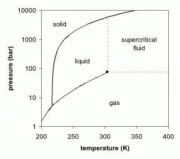Difference between revisions of "Supercritical fluid"
Jump to navigation
Jump to search
m (Text replace - "== Authority ==" to "== Sources Checked for Data in Record ==") |
|||
| Line 9: | Line 9: | ||
[[File:.jpg|thumb|Table of critical values]] | [[File:.jpg|thumb|Table of critical values]] | ||
| − | == | + | == Resources and Citations == |
| − | + | * Sung Mo Kang, Achim Unger, J.J. Morrell, 'The Effect of Supercritical Carbon Dioxide Extraction of Color Retention and Pesticide Reduction of Wooden Artifacts' ''JAIC'' 43(2) 151-160, 2004. | |
| − | + | * Wikipedia: http://en.wikipedia.org/wiki/Supercritical_fluid (Accessed Dec. 9, 2005) | |
| − | |||
| − | * Wikipedia | ||
[[Category:Materials database]] | [[Category:Materials database]] | ||
Revision as of 09:36, 14 June 2020
Description
A material compressed and heated to a point above its thermodynamic critical point. Supercritical fluids (SCF) have the unique ability to penetrate materials like a gas while also dissolving materials like a liquid. Carbon dioxide and water are the most commonly used supercritical fluids. A temperatures and pressures above the thermodynamic critical point, a material's liquid phase and the gas phase will have equal densities and are indistinguishable.
Synonyms and Related Terms
SCF
File:.jpg
Table of critical values
Resources and Citations
- Sung Mo Kang, Achim Unger, J.J. Morrell, 'The Effect of Supercritical Carbon Dioxide Extraction of Color Retention and Pesticide Reduction of Wooden Artifacts' JAIC 43(2) 151-160, 2004.
- Wikipedia: http://en.wikipedia.org/wiki/Supercritical_fluid (Accessed Dec. 9, 2005)
